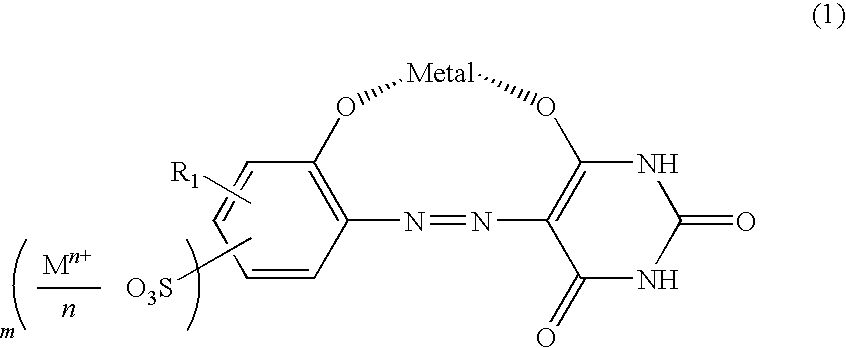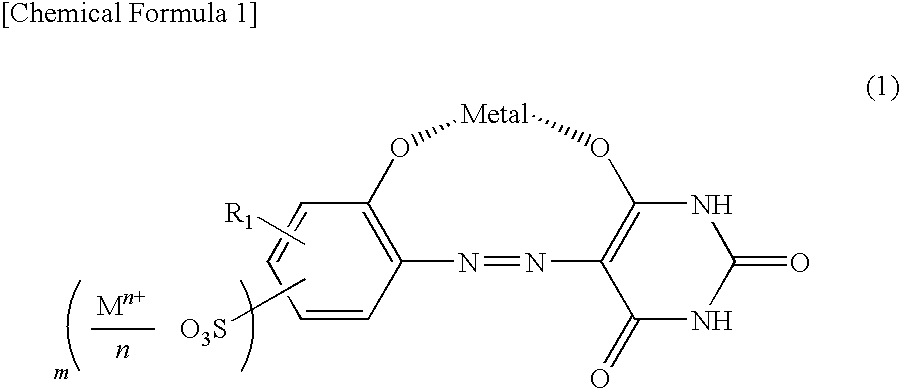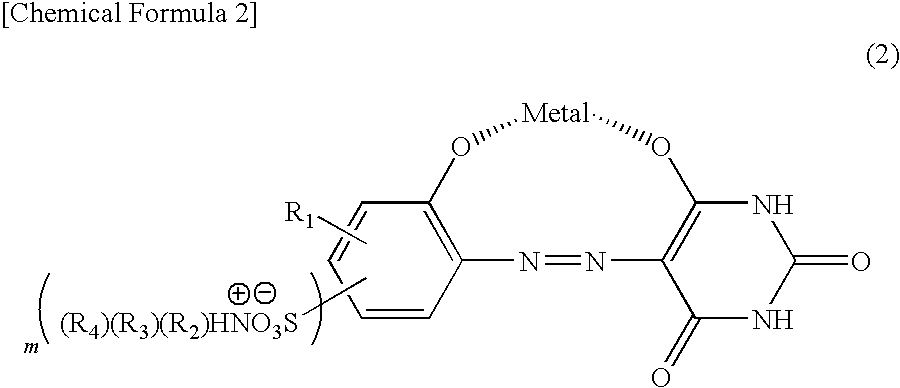Monoazo metal complex, azo-type pigment dispersant, and pigment composition comprising the azo-type pigment dispersant
a technology of azo-type pigments and complexes, which is applied in the direction of instruments, optical elements, transportation and packaging, etc., can solve the problems of increasing composition viscosity, increasing composition aggregation or precipitation, and increasing composition viscosity, so as to increase the concentration of pigments in the dispersion composition, increase the viscosity of the composition, increase the effect of aggregation or precipitation
- Summary
- Abstract
- Description
- Claims
- Application Information
AI Technical Summary
Benefits of technology
Problems solved by technology
Method used
Image
Examples
example 1
Synthesis of a Material Represented by Compound No. 1 in Table 1
[0065]94.6 parts of 2-aminophenol-4-sulfonic acid was suspended in 500 parts of water, and sodium hydroxide was used to completely dissolve the suspension at pH 6 to 7. 38.0 parts of sodium nitrite was also added to completely dissolve the suspension. The dissolved solution was dripped into 450 parts of 14% aqueous hydrochloric acid solution at 5 to 10° C. for 30 minutes. The mixture was stirred for 2 hours to perform a diazotization reaction. Subsequently, all the diazotized solution was dripped into an aqueous solution, in which 64 parts of barbituric acid are dissolved in 2400 parts of water, at 10 to 15° C. for 30 minutes and caustic acid was used to adjust pH of the mixture at 5 to 6. After a reaction was performed at the same temperature and pH for 15 hours, the solid phase was separated by filtration to obtain 151 parts of a compound represented by formula (12). Next, 151 parts of the compound represented by form...
example 2
Synthesis of a Material Represented by Compound No. 23 in Table 2
[0068]After 103.8 parts of the compound obtained in Example 1 was suspended in 7500 parts of water, sodium hydroxide was used at 20 to 25° C. for pH adjustment at 10 to dissolve a monoazo metal complex. To the thus obtained aqueous solution, a aqueous solution, in which 71.3 parts of 18-amino Abieta-8, 11, 13-trien was dissolved in 450 parts of 3.3% acetic acid aqueous solution, was dripped at 20 to 25° C. for 30 minutes, and the mixture was stirred at the same temperature for 1 hour, followed by filtration. A wet cake thus obtained was blow-dried at 80° C. to obtain 166 parts of a compound represented by Compound No. 23 in Table 2.
example 3
Synthesis of a Material Represented by Compound No. 14 in Table 1
[0069]A synthesis was performed in the same way as in Example 1, except that 2-aminophenol-4-sulfonic acid was replaced with 2-aminophenol-5-sulfonic acid, to obtain 160 parts of a compound represented by Compound No. 14 in Table 1.
PUM
| Property | Measurement | Unit |
|---|---|---|
| pH | aaaaa | aaaaa |
| pH | aaaaa | aaaaa |
| pH | aaaaa | aaaaa |
Abstract
Description
Claims
Application Information
 Login to View More
Login to View More - R&D
- Intellectual Property
- Life Sciences
- Materials
- Tech Scout
- Unparalleled Data Quality
- Higher Quality Content
- 60% Fewer Hallucinations
Browse by: Latest US Patents, China's latest patents, Technical Efficacy Thesaurus, Application Domain, Technology Topic, Popular Technical Reports.
© 2025 PatSnap. All rights reserved.Legal|Privacy policy|Modern Slavery Act Transparency Statement|Sitemap|About US| Contact US: help@patsnap.com



